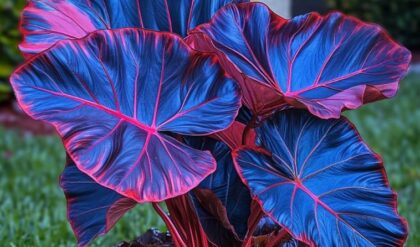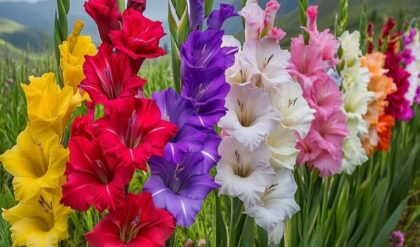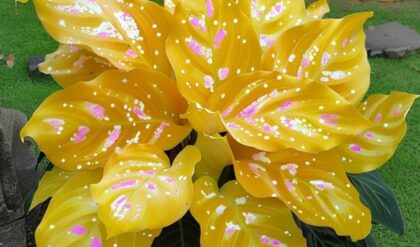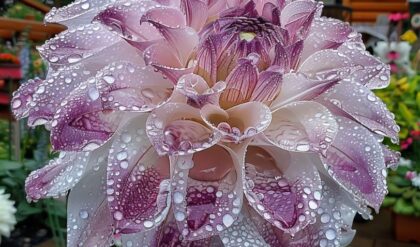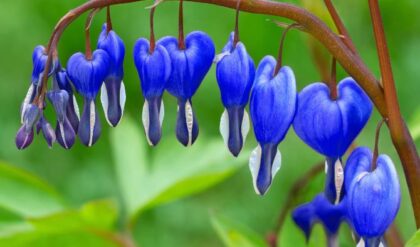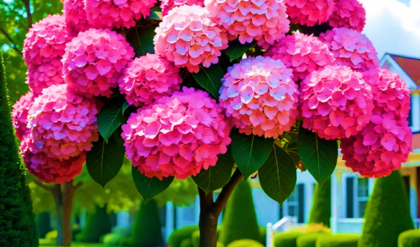The Hydrangea is more than just a flower; it embodies the delicate balance of nature’s artistry and human dedication to cultivating beauty. Known for its lush blooms that range in color from vibrant blues to soft pinks, this flower has captivated the hearts of garden enthusiasts for centuries. Yet, understanding hydrangeas goes beyond merely planting them; it requires immersing oneself in their unique characteristics and care requirements. Each variety, from the classic Hydrangea macrophylla to the charming Panicle Hydrangeas, tells a story of adaptation and resilience, echoing the rich tapestry of botanical history that can transform ordinary gardens into captivating landscapes. This journey into their cultivation is transformative, where novice gardeners discover not only horticultural expertise but also the deep connection between people and nature through nurturing these enchanting blooms.
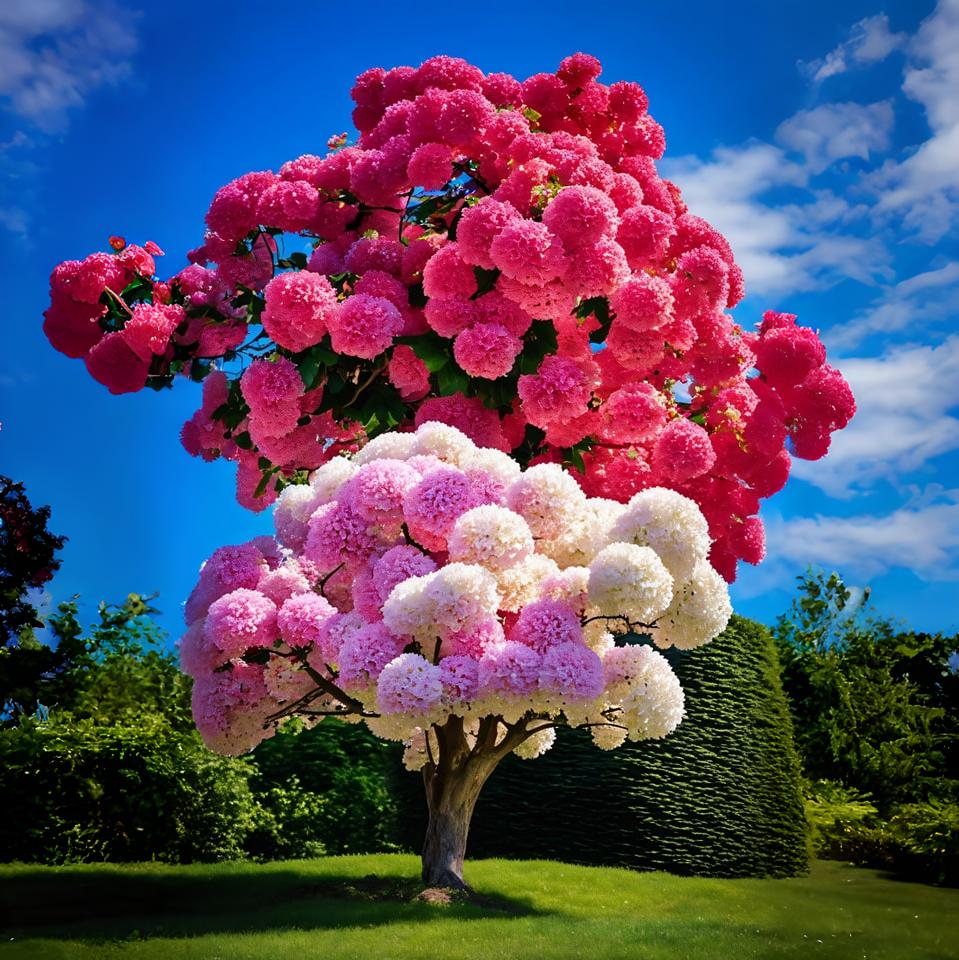
Cultivating the Beauty of Hydrangeas
Hydrangeas thrive on meticulous attention and care. From selecting the right type of soil to anticipating seasonal changes, these plants demand a gardener’s commitment to learn and adapt. One resource suggests that a comprehensive guide provides essential tips for both novice and experienced growers alike—emphasizing various aspects like sunlight requirements, watering techniques, and pruning strategies, which are pivotal to the lifecycle of hydrangeas. The sheer diversity among hydrangeas invites exploration; for instance, understanding how blue hydrangeas thrive in acidic soil versus the pink varieties flourishing in more alkaline conditions can redefine one’s approach to gardening.
Soil Preferences and Nutrient Needs
Hydrangeas have specific soil requirements that can significantly impact their growth and bloom quality. Understand Your Soil’s pH: The pH level of the soil is a crucial factor in determining the color of Hydrangea macrophylla blooms. Acidic soils, with a pH below 6.0, tend to produce blue flowers, while more alkaline soils, with a pH above 6.0, result in pink blooms. Gardeners can use soil test kits to determine the pH of their soil and make necessary adjustments through the addition of sulfur (to lower pH) or lime (to raise pH).
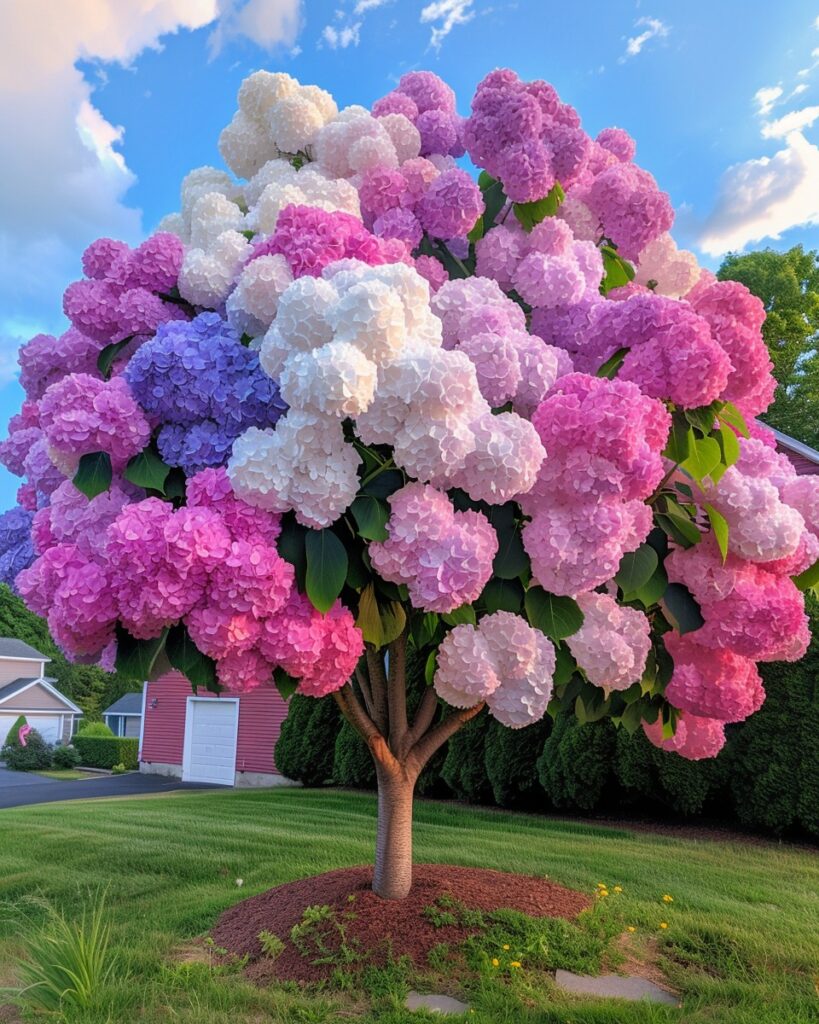
In addition to pH, hydrangeas also require well-draining, nutrient-rich soil. Amend the Soil with Organic Matter: Incorporating compost, peat moss, or other organic materials into the soil can improve its structure, drainage, and nutrient content. This helps provide the necessary sustenance for the plants to thrive. Remember to avoid heavy clay soils, as they can lead to waterlogging and root rot.
Sunlight Requirements and Placement
Hydrangeas have varying sunlight needs depending on the specific variety. Full Sun or Partial Shade: Some species, such as Panicle Hydrangeas (Hydrangea paniculata), thrive in full sun, while others, like Bigleaf Hydrangeas (Hydrangea macrophylla), prefer partial shade, especially during the hottest hours of the day. Carefully consider the microclimate of your garden and choose the appropriate hydrangea variety that matches the available sunlight conditions.
When selecting a planting location, also take into account factors such as wind exposure and proximity to structures. Hydrangeas can be sensitive to strong winds, which can damage their large, fragile blooms. Positioning them in sheltered areas or using wind breaks can help mitigate this issue.
Watering and Moisture Management
Maintaining the right balance of moisture is crucial for the health and vigor of hydrangeas. Consistent Watering: Hydrangeas require consistent watering, especially during the growing season and periods of drought. Aim to keep the soil consistently moist, but avoid waterlogging, as this can lead to root rot and other problems.
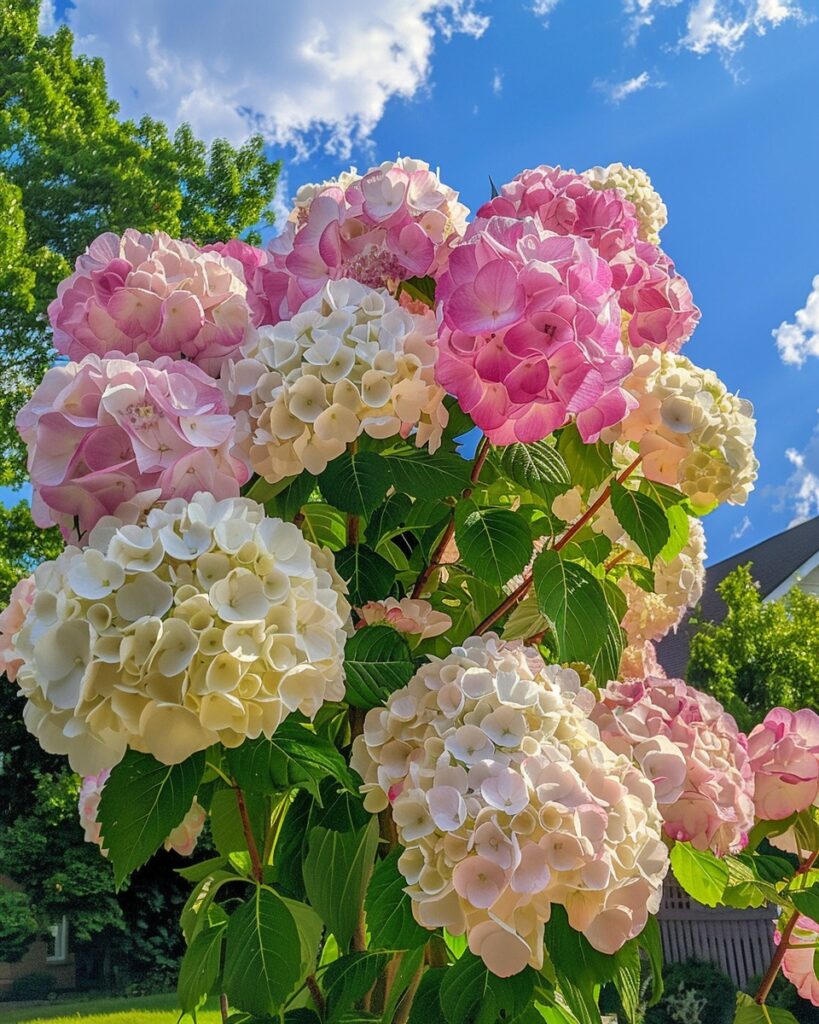
Mulching for Moisture Retention: Applying a 2-3 inch layer of organic mulch, such as wood chips or pine needles, around the base of the plants can help retain soil moisture and suppress weed growth. Be mindful not to let the mulch touch the stems, as this can cause rot.
Pruning Strategies and Techniques
Pruning is an essential aspect of hydrangea care, as it helps maintain the plant’s shape, size, and flowering potential. Timing is Key: The optimal time to prune hydrangeas varies depending on the species. Some varieties, like Bigleaf Hydrangeas, bloom on old wood, meaning they set their flower buds the previous year. Pruning these in late winter or early spring can remove potential blooms. Other types, such as Panicle Hydrangeas, bloom on new wood and can be pruned in late winter or early spring.
Selective Pruning Techniques: When pruning hydrangeas, focus on removing dead, damaged, or overcrowded stems. Make clean, angled cuts just above a set of healthy buds or leaf nodes. Avoid cutting the plant back too severely, as this can compromise its vigor and flowering potential.
Seasonal Insights: Planting at the Right Time
Timing plays a crucial role in cultivating hydrangeas. The ideal time for planting these beauties is during spring when the echoes of winter are gently nudged away by the warmth of the sun. This transition marks a period of awakening, mirroring the hydrangea’s own journey toward vibrancy and growth. Engaging with this cyclical process reveals profound lessons about patience and nature’s rhythms. As buds awaken and bloom, so too does a gardener’s passion, reflecting how nurture begets beauty, intertwining human effort with natural cycles in an exhilarating dance of life.
Choosing the Right Planting Time
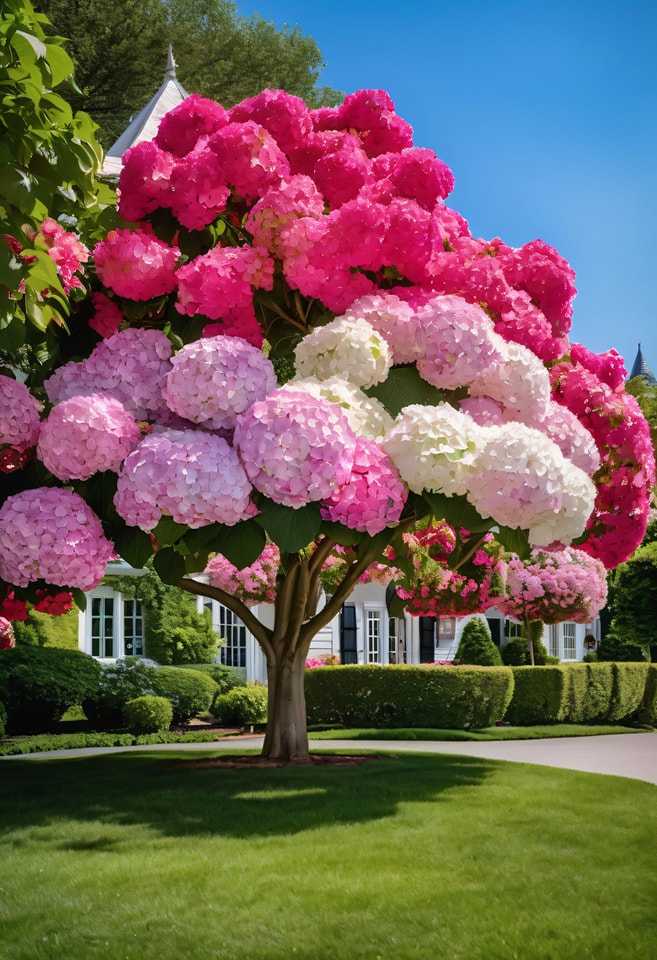
Hydrangeas thrive when planted in the spring, typically between March and May, depending on your local climate. This timing allows the plants to establish their root systems before the heat of summer arrives, giving them a better chance of survival and optimal growth.
Avoid Planting in Summer: Planting hydrangeas during the heat of summer can be stressful for the plants, as they may struggle to adapt to the new environment and establish their root systems. The intense sun and heat can also cause transplant shock, leading to wilting, leaf scorch, and potential plant loss.
Preparing the Planting Site
Before planting, take the time to prepare the soil and the planting site. Amend the Soil: Incorporate organic matter, such as compost or well-rotted manure, into the soil to improve its structure and nutrient content. This will provide the necessary sustenance for the hydrangeas to thrive.
Choose the Right Spot: Select a location that offers the appropriate sun exposure for the specific hydrangea variety you’re planting. Consider factors like wind protection, proximity to structures, and overall drainage to ensure the plants have the best possible growing conditions.
Transplanting and Dividing Established Plants
If you’re working with established hydrangeas, you may need to transplant or divide them to maintain their health and vigor. Transplanting in Spring: The best time to transplant hydrangeas is in early spring, before new growth emerges. Carefully dig up the plant, preserving as much of the root system as possible, and replant it in the desired location.
Dividing Overcrowded Plants: Older hydrangeas can become overcrowded, limiting their ability to produce lush, abundant blooms. Dividing the plant every few years can rejuvenate it and encourage better growth. Divide the plant in early spring, ensuring each division has a healthy root system and at least one or two sturdy stems.
The Art of Pruning: Crafting Ideal Blooms
Pruning hydrangeas may initially seem daunting, yet it is an essential art form that adds value to your garden. Each snip and cut is akin to sculpting a masterpiece, shaping life and directing energy toward the healthiest stems. Different species have specific requirements on how and when to prune, a fact that enlightens the gardener’s journey. The act of pruning is metaphorical: just as we must trim back certain aspects of our lives to allow for growth, so too do hydrangeas require careful editing to flourish, emphasizing the importance of attentiveness in cultivating both flowers and character.
Pruning Bigleaf Hydrangeas (Hydrangea macrophylla)
Bigleaf Hydrangeas, known for their stunning mophead or lacecap blooms, require a unique pruning approach. Prune in Late Winter or Early Spring: The optimal time to prune these hydrangeas is in late winter or early spring, before new growth emerges. This ensures you’re working with the previous year’s stems, which is where the flower buds will form.
Selective Thinning and Heading Back: When pruning Bigleaf Hydrangeas, focus on thinning out overcrowded or damaged stems, cutting them back to just above a set of healthy buds. Avoid cutting the plant back too severely, as this can reduce the number of potential blooms.
Pruning Panicle Hydrangeas (Hydrangea paniculata)
Panicle Hydrangeas, with their distinctive cone-shaped flower heads, require a slightly different pruning approach. Prune in Late Winter or Early Spring: Similar to Bigleaf Hydrangeas, the best time to prune Panicle Hydrangeas is in late winter or early spring, before new growth appears.
Rejuvenation Pruning: Panicle Hydrangeas can benefit from more extensive pruning, as they bloom on new wood. Consider cutting the plant back by one-third to one-half of its height, encouraging the development of strong, healthy stems that will support the upcoming season’s blooms.
Pruning Oakleaf Hydrangeas (Hydrangea quercifolia)
Oakleaf Hydrangeas, with their striking oak-shaped leaves, also have their own pruning requirements. Prune after Flowering: The ideal time to prune Oakleaf Hydrangeas is in the late summer or early fall, after the plant has finished flowering. This allows the plant to redirect its energy into developing strong stems and buds for the next season’s blooms.
Selective Thinning and Shaping: When pruning Oakleaf Hydrangeas, focus on removing any dead, damaged, or overcrowded stems. Gently shape the plant, maintaining its natural, graceful form while encouraging new growth and improved air circulation.
Botanical Traditions and Innovations
Moreover, the hydrangea isn’t just a plant; it exists within a cultural context ripe with traditions. Historically cherished for their medicinal properties, some extracts of hydrangeas are now celebrated for potential skincare benefits, integrating them into modern wellness trends. This juxtaposition between historical reverence and contemporary application provokes intriguing discussions about how nature informs culture and vice versa. It raises questions such as: how can traditional practices shape our current approaches to health and beauty? The possibilities unfold when one considers hydrangeas through multiple lenses—botanical, aesthetic, and social.
Hydrangeas in Traditional Medicine and Herbalism
Throughout history, various cultures have recognized the medicinal properties of hydrangeas. Traditional Chinese Medicine: In Traditional Chinese Medicine (TCM), the roots and leaves of certain hydrangea species have been used to treat a variety of ailments, including inflammation, fever, and digestive issues. Practitioners have long valued the plant’s diuretic and anti-inflammatory properties.
Native American Herbal Traditions: Some Native American tribes, such as the Cherokee, have incorporated hydrangeas into their traditional herbal practices. The roots and leaves were used to treat conditions like skin irritations, respiratory problems, and even snakebites.
Hydrangeas in Modern Wellness and Skincare
As scientific research continues to explore the active compounds within hydrangeas, new applications in modern wellness and skincare have emerged. Antioxidant and Anti-Aging Benefits: Studies have suggested that hydrangea extracts may possess potent antioxidant properties, making them potentially beneficial for skincare products aimed at reducing the visible signs of aging.
Anti-Inflammatory and Soothing Properties: The anti-inflammatory compounds found in hydrangeas have led to their incorporation into various skincare formulations, particularly for products targeting sensitive or irritated skin.
Exploring the Intersection of Nature and Culture
The evolving role of hydrangeas, from traditional medicine to modern wellness, highlights the intricate relationship between nature and culture. Honoring Traditional Knowledge: As we embrace new discoveries and innovations, it is important to recognize and respect the traditional knowledge that has been passed down through generations. Integrating these time-honored practices with scientific advancements can lead to a more holistic understanding of the plant’s potential.
Sustainable Stewardship: The conservation and sustainable cultivation of hydrangeas are crucial as we continue to explore their multifaceted benefits. Balancing the demands of modern usage with the need to protect natural habitats and biodiversity is a vital consideration in this evolving narrative.
From Garden to Ecosystem: The Broader Impact
The hydrangea’s role extends into supporting local ecosystems. By providing food for bees and butterflies, these blooms contribute significantly to habitat sustainability. Thus, caring for hydrangeas cultivates not only beauty in our private spaces but fosters a broader ecological impact. This created synergy between individual gardens and wider environmental needs reflects an interconnectedness especially relevant in today’s world, where maintaining biodiversity is paramount for our planet’s health.
Hydrangeas as Pollinator-Friendly Plants
Hydrangeas are a valuable resource for pollinators, such as bees and butterflies, offering both nectar and pollen. Attracting Pollinators: The abundant blooms of hydrangeas provide a reliable source of sustenance for these vital insects, particularly during times when other floral resources may be scarce.
Supporting Biodiversity: By including hydrangeas in your garden, you’re not only contributing to the visual beauty of your outdoor space but also actively supporting the health and resilience of local ecosystems. This small but impactful act helps maintain the delicate balance that sustains diverse plant and animal life.
Hydrangeas and Water Conservation
In addition to their ecological benefits, hydrangeas can also play a role in water conservation efforts. Drought-Tolerant Varieties: While hydrangeas generally require consistent moisture, certain varieties, like the Panicle Hydrangea (Hydrangea paniculata), are more drought-tolerant and can adapt to drier conditions. Incorporating these species into your garden can help reduce water usage while still enjoying the enchanting beauty of these blooms.
Water-Wise Gardening Techniques: Employing water-wise gardening practices, such as mulching, efficient irrigation, and selecting appropriate planting locations, can further optimize the water usage for your hydrangeas. This not only benefits the plants but also contributes to the broader sustainability of your local environment.
Hydrangeas in Sustainable Landscaping
The hydrangea’s multifaceted role extends to sustainable landscaping practices. Integrating Hydrangeas into Diverse Gardens: By incorporating hydrangeas into a diverse array of plants, you can create visually stunning and ecologically balanced gardens. This approach helps foster a thriving habitat that supports a wide range of species, from pollinators to small wildlife.
Hydrangeas as Part of Naturalistic Designs: The graceful, flowing forms of hydrangeas lend themselves well to naturalistic garden designs that mimic the patterns and compositions found in the wild. This integration can contribute to a more harmonious and sustainable landscape that blends seamlessly with the surrounding environment.
Conclusion
Engaging with the enchanting hydrangea entices us into a world where gardening transcends simple aesthetics. It propels us into rich narratives that connect us with time-honored traditions while embracing sustainable practices, encouraging harmony between nature and humanity. Through the cultivation of these captivating blooms, we uncover a deeper understanding of the natural world, the rhythms of the seasons, and the profound interplay between human endeavor and the inherent beauty of the botanical realm. As we delve into the comprehensive guide of the hydrangea, may we be inspired to not only cultivate these magnificent flowers but also nurture the profound connections that they represent, fostering a more vibrant and sustainable future for our gardens and our world.
